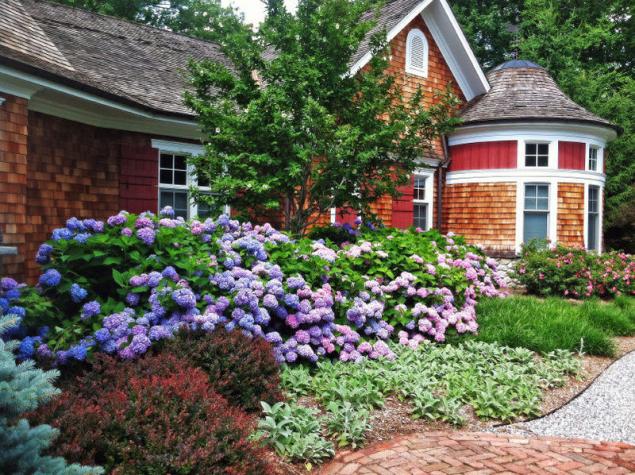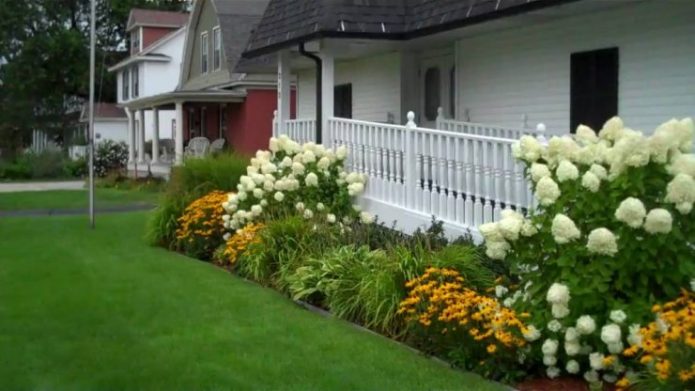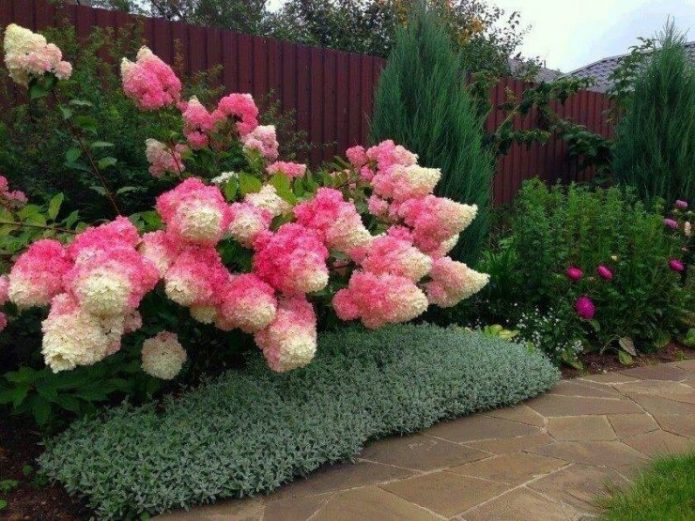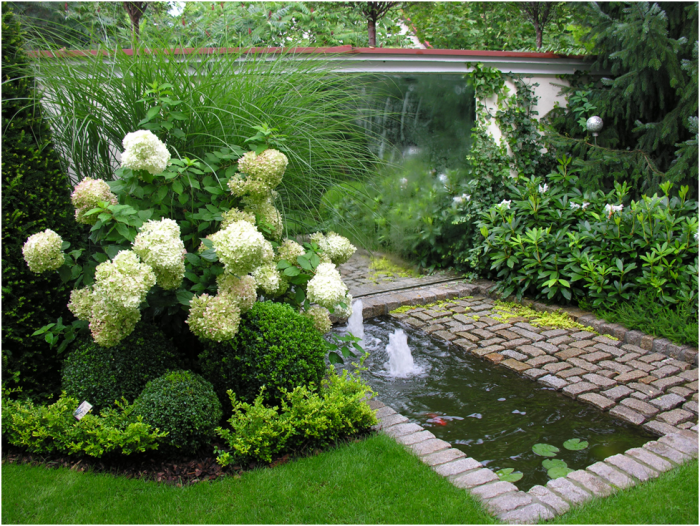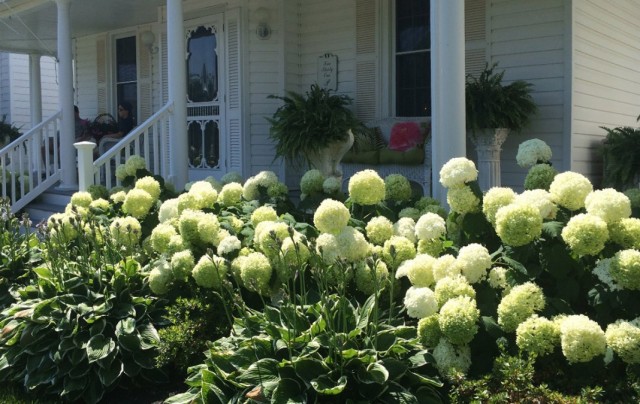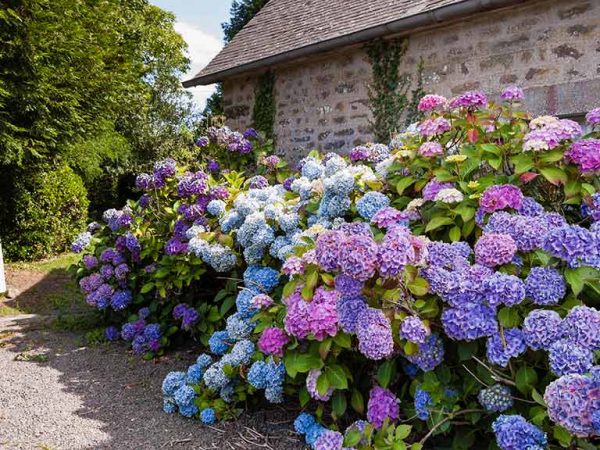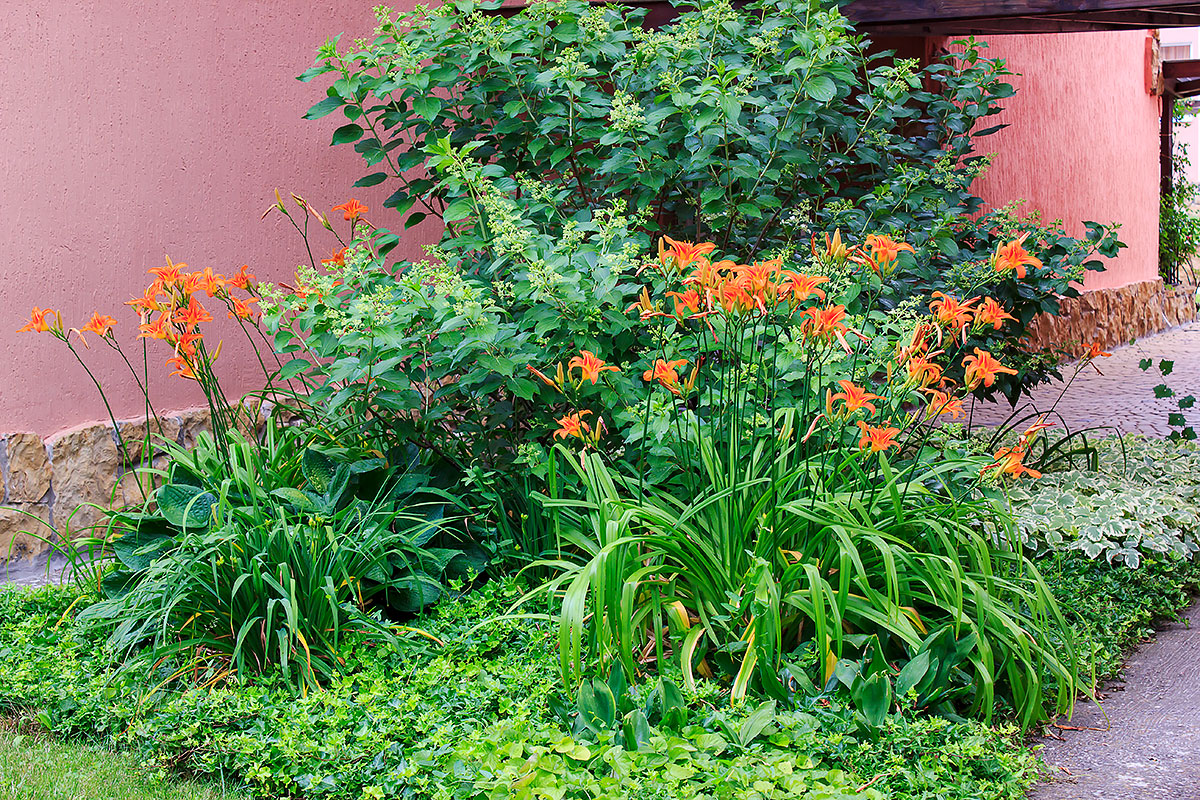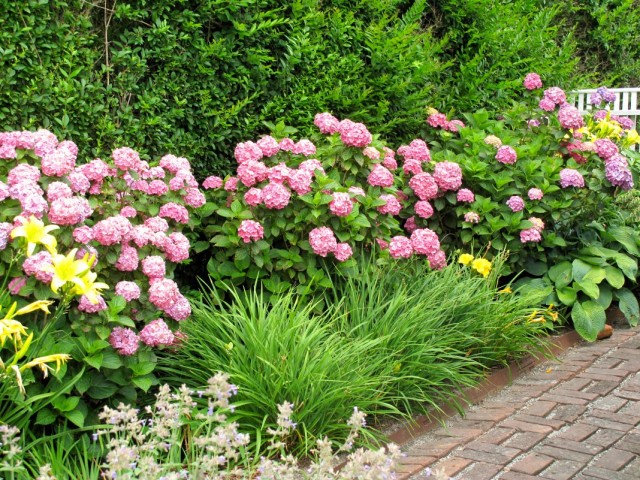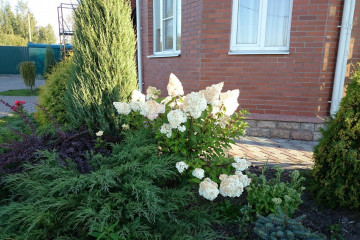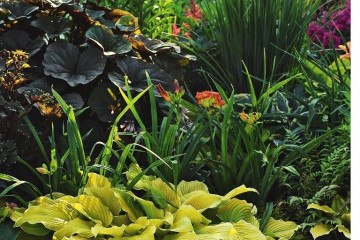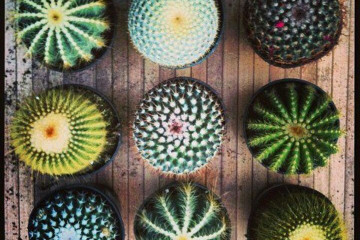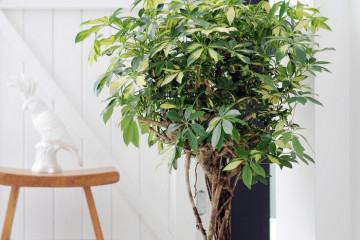Flowerbed with hydrangea - planting scheme of bushes
Content:
A beautiful blooming corner can decorate any personal plot, alley, park or pond. It is not surprising that all gardeners, even beginners, strive to create interesting compositions of flowers, herbaceous ornamental plants, flowering bushes and trees in their garden. One of the win-win options, which are also used by experienced landscape designers, amateur flower growers, is a flower bed with a hydrangea. This spectacular culture pleases with beautiful lush flowering for a long time and, under suitable conditions, does not require painstaking care. In addition, hydrangea goes well with many plants, it becomes possible to create unique and original ensembles.
Hydrangea in landscape design
A flower garden with hydrangea is always a bright colorful composition that constantly pleases with fresh colors, thanks to the continuous flowering of hydrangea throughout the summer and early autumn.
Several types of culture are used in landscape design:
- Tree-like. Tall species, characterized by stability and undemanding care, withstands low temperatures. It stands out with an inflorescence in the form of a ball.
- Paniculata. A popular plant of medium height (up to a meter), the main feature of which is a panicle-shaped inflorescence. It is considered a universal culture.
- Large-leaved. A beautiful bush with lush large inflorescences, flower growers really like it, but it takes root only in the southern regions. It is often used as an indoor flower.
The most demanded for planting in the garden is the panicle hydrangea - it fits harmoniously into any design, is unpretentious, has many varieties.
There are many versions of the use of hydrangea in landscape design, it all depends on the skills and creative impulses of the florist. There are simple and effective hydrangea garden designs that people can implement without experience in creating complex compositions.
Planting scheme for hydrangea paniculata
Considering the size of the plant, the duration, brightness and splendor of flowering, hydrangea often becomes the dominant in the composition. If the flower garden is clearly visible from all sides, the bush is planted in the center. In the flower garden near the fence - in the background.
When using hydrangea in garden design, some care features must be taken into account:
- The flower loves partial shade, diffused sunlight. Do not plant a bush in a sunny, leeward place.
- Hydrangea needs regular watering. In order for the roots not to rot, it is necessary to use drainage in the form of rubble or gravel when planting. Mulching with needles or sawdust will help retain moisture longer.
- The plant grows well in acidic loose soils, but does not tolerate alkaline clay soil.
Principles of flower garden formation:
- Choosing a place. The flower garden should be a decoration of the garden, attract attention. Therefore, the site is selected clearly visible, but slightly shaded.
- A scheme is being thought over.In order for the flowerbed to blend harmoniously with the surroundings, it must correspond to the size of the garden, be combined with the overall design and concept. It is best to first draw a diagram of the flower garden on paper, mark the diagram with pegs on the ground.
- Prepare the soil. One of the key points is light fertile soil, which is the foundation for future abundant flowering. The site is dug up, weeds are removed, sand, humus, ash are introduced, everything is thoroughly mixed and watered abundantly.
Competent selection of plants
Using hydrangea in a flower garden, you must adhere to the basic rules for planting flowers:
- Tall flowers and bushes are planted in the center: hydrangea, rose, daylily, delphinium, peony, iris, gladiolus. Gradually the level decreases: tulips, daffodils, zinnias, marigolds, violets, petunias. Ground cover plants will help to fill in empty areas and complete the composition: periwinkle, herbal carnation, lungwort.
- The period and timing of flowering of each culture are taken into account - the flowers must be placed in the flower bed in such a way as to achieve harmonious flowering throughout the season. Herbaceous plants will help to complete the picture: hosts, ferns, red fescue.
- Think over the color scheme of the flower bed. A combination of contrasting, bright shades is possible: blue, yellow, red, white, green. More restrained noble designs are often used in one palette. White flower beds look good. Red shades (from rich burgundy and wine to pale pink), yellow (from orange and to lemon and pale yellow) are interestingly revealed.
Considering all the nuances of growing, the best option for combining with hydrangea are:
- Trees and bushes - rhododendron, barberry, viburnum, conifers (thuja, pine).
- Bulbous - tulips, daffodils, daylilies, crocuses, hyacinths.
- Perennials - rose, astilba, phlox, geranium, anemone.
- Annuals - marigolds, pansies, gerberas, dahlias, petunias.
- Herbaceous plants - ferns, hosts, mint, wormwood, periwinkle.
The composition with hydrangea in the garden should be combined with the general theme: the design of the house and the backyard area. Several design options are popular:
- Country style. To create it, bright colors and plants are used that resemble a rural garden: meadow (chamomile, thyme, cornflower, wormwood), annuals (marigolds, violets, zinnias, Carpathian bells), herbaceous (periwinkle, mint, ivy, ornamental cabbage), trees ( viburnum, willow).
- Classic style. Suitable for decorating a plot in a modern, discreet design. This option involves a combination of hydrangeas and conifers, roses, ferns or host, ornamental onions, petunias.
- Japanese style. A fashionable trend in landscape design is the creation of a Japanese garden. To design it, you need a small fountain or trickle, which is complemented by rhododendron, fan maple, fern and moss. Low-growing chrysanthemums will add brightness to the composition.
Compositions with hydrangea in the garden
There are several options for combining hydrangea with other plants, which are always win-win and effective.
A flower bed with hydrangeas and hosts is a classic combination that is striking in its simplicity and style. The luscious greenery of the host favorably sets off the delicate bloom of the hydrangea. The variety of colors of both cultures allows you to create original and beautiful compositions.In addition, both hydrangea and hosta love shaded areas and retain their attractive appearance for a long time. Caring for such a flower garden is extremely simple.
Hydrangea and coniferous compositions are the optimal combination. Ephedra oxidize the soil, which is so necessary for hydrangeas. In addition, flowers against the background of rich coniferous greenery seem even more beautiful and graceful. Hydrangea looks good in tandem with spruce, juniper, fir, pine. You can complement the composition with roses or ferns.
Flower bed for beginners
To embody a simple flower bed, it is advisable to use flowers that do not require special care and growing conditions, but you can be sure of their long attractive appearance and flowering time. As a basis for a simple flower bed, you can take the scheme: in the center of a hydrangea, bulbs (daffodils and tulips), astilbe, fern, chrysanthemum, violet, lily of the valley, marigolds, grass carnation are planted in a circle.
Children's flower bed
Creating a children's flower bed is a great way to captivate a child, teach him to work, respect for nature, and responsibility. To make the lesson fun, you can plant colorful flowering bushes.
At the same time, when decorating a flowerbed for a boy, flowers in a blue-blue range are used (crocuses, violets, muscari, delphiniums, woodlands, forget-me-nots, cornflowers, nigella, asters). The highlight of the composition can be blue or purple hydrangea, as well as blue spruce.
For girls, delicate flowers of red-pink color are selected (hyacinths, tulips, peonies, lilies, daisies, pansies, petunias). Viburnum or rhododendron can supplement the flower bed.
Shady flower bed with daylilies
If there is a need to decorate a corner where there is almost no sun, you can try the next version of the flower bed. In the center - hydrangea of the Kiushu variety and daylilies (common red or Stela de Oro). Further - daffodil late blooming, hosta Zibolid, forest violet, ivy and catchment. Such a composition always looks fresh and original, practically does not need maintenance.
A flower bed along a fence or wall
A riot of hydrangeas along the wall of a house or a fence is a stunning and unique sight. This is difficult to achieve, but impressive. When planting hydrangeas, you should immediately determine which plant will be the tallest. If it is a hydrangea, then a tree-like species is selected and planted in the background. In front, the flower garden is complemented by small flowers and herbaceous plants.
If an ephedra or other tree is chosen as the largest crop, then it is placed in the back. Hydrangea should be picked up paniculata and planted in the first row.
Hydrangea is a beautiful and spectacular plant that is unpretentious in care and is in demand in landscape design. It goes well with many flowers, trees, herbaceous plantings, thanks to which you can create original and unique compositions. Hydrangea will be a worthy decoration for any garden or flower garden.
